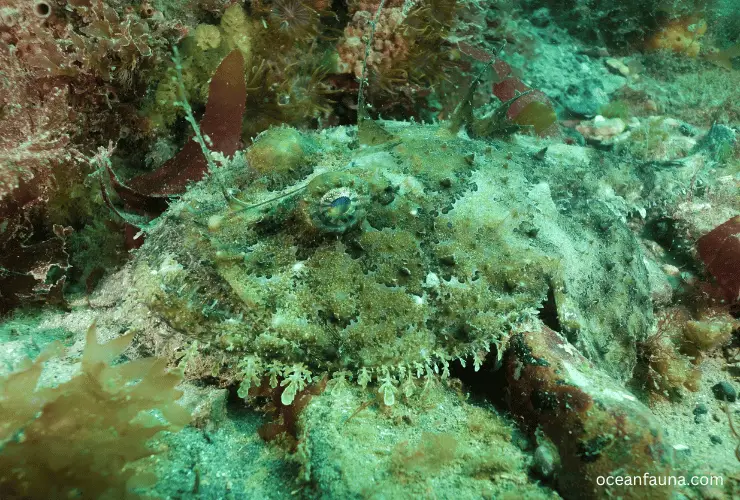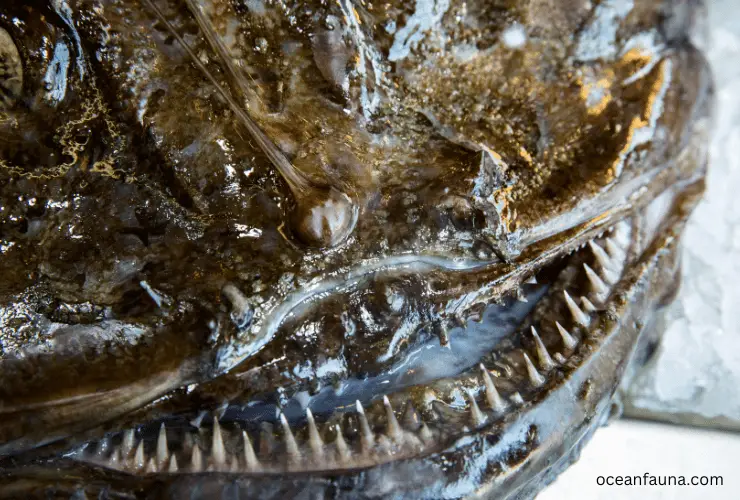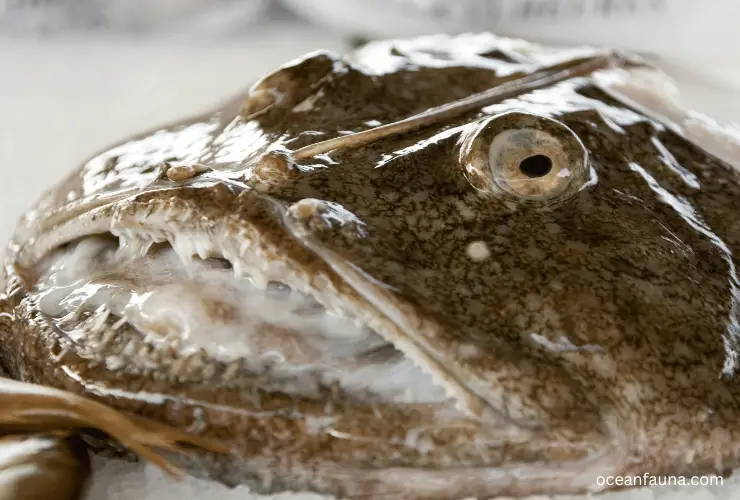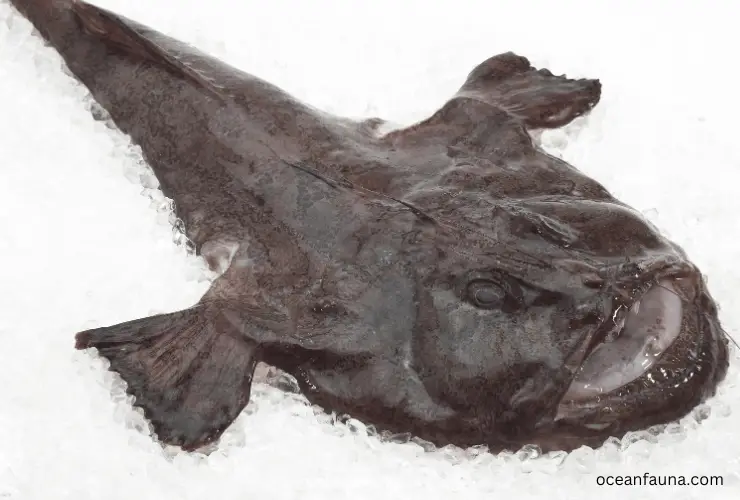The giant monkfish also known as big mouth anglerfish, is the master of camouflage, with its brownish-gray skin and frilly fins that blend seamlessly into its surroundings.
But its most distinctive feature is its enormous mouth, which can expand to nearly the size of its entire body. It allows the monkfish to swallow prey much larger than itself, such as other fish and crustaceans.
What’s more interesting is that this giant monkfish uses a bioluminescent lure to catch prey. When unsuspecting prey gets close enough, the anglerfish strikes with lightning-fast speed, snatching up its meal in a matter of seconds.
But despite its formidable appearance and hunting prowess, the giant monkfish is not a threat to humans. In fact, it is a popular food fish in many parts of the world, prized for its delicate flavor and firm texture. Read on to learn more about this big-mouth anglerfish.
About Giant Monkfish – A Quick Biology
Let’s take a quick look at this giant fish species.
| Parameters | Details |
| Scientific name | Lophius Piscatorius |
| Kingdom | Animalia |
| Family | Lophiidae |
| Genus | Lophius |
| Phylum | Chordata |
| Class | Actinopterygii |
| Order | Lophiiformes |
| Species | L. Piscatorius |
| Habitat | Saltwater Generally found at 20 to 1,000-meter depths. |
| Life Span | 24 years |
| Diet | sand eels, cod, pollock, coalfish, dogfish, all kinds of flatfish, and small rays |
| Geography | East Atlantic Mediterranean |
| Other names | Big mouth anglerfish, Headfish, Frog-fish, Goosefish, and sea-devil |
Geographic Distribution of Giant Monkfish
According to ICES Journal of Marine Science, Giant monkfish are mainly located in coastal waters of the northeast Atlantic, including the Barents Sea and the Strait of Gibraltar. It is also found in the Mediterranean Sea, including the Black Sea.

In the North Atlantic Ocean, they live along the coast of Greenland and the entire coastline of Iceland. Their range extends as far north as the tip of Norway. It runs the length of the United Kingdom to the south. They are also found along the coast of western Africa, as far south as Namibia.
As per another research of Scientia Marina, giant monkfish are particularly abundant in most British waters, especially the south coast and West Country.
Habitat and Range of Giant Monkfish
According to ADW, monkfish are deep-water fish that prefer to live in muddy or sandy bottoms, often at depths ranging from 100 to 500 meters. However, they can be found at depths of up to 1000 meters.
They may swim as deep as 2000 meters in offshore waters to spawn. Juvenile monkfish inhabit shallower waters than adults, usually in depths of 10 to 100 meters.
The monkfish can also be found in shells, gravel, and sometimes rocky spots. Its ability to adapt to various types of sea beds and environments makes it a highly adaptable species that can thrive in multiple habitats.
Appearance of Giant Monkfish
The giant monkfish, commonly known as anglerfish, is a fascinating creature easily recognizable due to its unique appearance. This fish has a huge head that is particularly broad, flat, and depressed, making the remaining body look tiny in comparison.
What’s most striking about its head is its wide mouth covering almost all of it, with both jaws equipped with long, sharp teeth sloped slightly inwards. Once the jaws have closed, it’s practically impossible for the prey to escape from their grasp.

The monkfish’s skin is thick and rough. It is not adorned with scales like most fish. Instead, it is covered in spines and bumps. It has structures resembling small seaweed branches extending from its skin.
These fish can grow up to 200 cm long, making them one of the largest anglerfish species. Its coloration varies depending on its habitat. It is typically a mottled brown or greenish-brown, with darker spots and patches that provide additional camouflage.
Also Read: Cusk Eel: The Most Diverse Groups of Deep Ocean Creatures
The pectoral and pelvic fins of the monkfish are both significantly pronounced, allowing it to move along the seafloor. It has a tapered tail that helps it maneuver through the water with ease. They have large, expandable stomachs that allow them to swallow prey with similar body sizes.
They also have a fleshy lure that dangles from a protrusion on their forehead. It helps to attract smaller fish and crustaceans that the anglerfish can swallow with its massive jaws.
Behavior of Giant Monkfish
The giant monkfish has remarkable behavioral adaptations that enable it to thrive in its sandy, benthic environment. Its ability to camouflage and hide among the sand and sediment makes it a master of disguise. Its unique feeding habits and digestive system make it a true wonder of nature.
According to the Journal of the Marine Biological Association of the United Kingdom, the monkfish uses its thick, strong pelvic fins to loosen the sediment around it. And then, it scoops sand underneath with its flexible, fan-shaped pectoral fins.
Since they eat in large quantities, it takes their bodies some time to digest the enormous feast they just swallowed, leaving them vulnerable to predators.
This digging action helps the fish bury itself more deeply in the sand, lying more flatly and further camouflaging its presence.
Moreover, they can adjust their coloration to match their surroundings, making them hard to spot.
Feeding/Diet- Are Giant Monkfish Omnivorous, or Carnivorous?
Monkfish are carnivores with an extensive diet. They feed on various fish, including coalfish, cuttlefish, haddock, cod, pouting, herring, pollock, sand eels, and flatfish.
It is an ambush hunter, lying motionless on the seabed, camouflaged and waiting for unsuspecting prey to pass by. They also feed on other marine organisms, such as crabs, lobsters, squid, octopuses, and even small sharks.
Additionally, it has been observed that Lophius piscatorius can even prey on seabirds, such as seagulls, in shallow waters. The monkfish’s diet suggests that it is an opportunistic feeder, eating whatever it can catch, making it a formidable predator in the ocean.
Reproduction of Giant Monkfish
According to NOAA, giant monkfish are benthic species that reproduce through external fertilization. The species attains sexual maturity at approximately 55–65 cm. The breeding season of the monkfish varies depending on its location but generally takes place between January and June.

Mating involves the male biting the female and remaining attached for several hours. Once fertilized, the female produces many small, violet eggs (around 1 million per female), which are released into the water column.
The eggs are encased in a floating, gelatinous ribbon several centimeters wide and up to 10 meters long. The ribbon naturally breaks apart due to wave motion.
After hatching, the monkfish larvae are pelagic (live in open water). The eggs hatch into planktonic larvae that drift with the ocean currents. As they grow and undergo metamorphosis, they transform into juveniles that exceed 5-8 cm long. At this point, they begin to move toward the sea floor and start their benthic life.
Moreover, studies suggest that L. piscatorius is a hermaphrodite species, with individuals being able to switch sexes from male to female during their lifetime. This occurs more commonly in larger individuals, with those over 90 cm long being primarily female.
Gills and Ventilation of Giant Monkfish
Oxygen is often scarce in the deep-sea environment where the giant monkfish live. To compensate for this, the giant monkfish has a big gill chamber supported by prolonged branchiostegal rays that end in a gill opening shaped like a siphon. This opening is located underneath and behind the base of their pectoral fin.
Unlike most fish, which rely on swimming to force water over their gills, these anglerfish use a passive ventilation system that relies on the natural movement of water. This specialized ventilation system allows them to take in as much oxygen as possible from the water.
Predators: Who Eats Giant Monkfish?
The giant monkfish has a few predators to watch out for. Despite their intimidating appearance and large size, monkfish can still fall prey to some predators in their natural habitat.
Sharks, bigger fish like cod and halibut, and marine mammals such as seals and dolphins are some of the main predators of monkfish. These predators may try to attack and eat the monkfish, especially if they are smaller or weaker. Additionally, some marine mammals like seals and sea lions have been known to prey on monkfish.
Giant Monkfish for Humans
Although they look scary, people like to eat monkfish. But you can only eat certain fish parts, like the liver, tail, body, and cheeks.
The Japanese treat the liver of the monkfish with salt and rice wine. They steam it and serve it with yummy veggies, herbs, and a sauce made from citrus fruits. This dish is called Ankimo, and it’s so good that it’s been named one of the top fifty best foods in the world by CNN.
Commercial trawlers don’t usually try to catch monkfish. Still, they’re always happy when they accidentally find them while trying to catch cod, haddock, and flatfish. Smaller-scale fisheries may use special nets to catch them.
Fossil Records
The monkfish species called Lophius piscatorius has been around for a very long time—about 70 million years ago. Scientists have found fossils that show early monkfish looked different than the ones we see today. They had a longer body shape and didn’t have the flat, broad head of modern monkfish.
Around 50 million years ago, monkfish underwent a significant change in shape. They developed a much flatter and broader head, which is now a defining feature of all monkfish species.
Scientists have found fossils of Lophius piscatorius in different parts of the world, like Europe, North America, and Africa. One interesting example was found in Germany in the 1800s, and it’s now kept in the Natural History Museum in London. This particular specimen is from around 34 million years ago.
Can Giant Monkfish Glow in the Dark?
Giant monkfish have a fantastic ability to produce and emit light, a process known as bioluminescence. They have special cells called photophores on their body and at the end of a unique structure on their head called the esca that produces the light.
The esca is a fleshy, glowing lure this anglerfish uses to attract prey in the ocean’s dark depths. The light it produces is often blue or green, making it less noticeable to other fish and prey in the deep-sea environment.
Scientists believe that the monkfish’s ability to produce bioluminescence evolved as a way to communicate with others. Further, it helps avoid predators in the deep-sea environment, where little or no sunlight penetrates.
FAQs
Can you eat monkfish?
Yes, monkfish is edible. In fact, it is a delicacy in many parts of the world. The flesh of the monkfish is often described as firm, white, and sweet, with a texture similar to lobster. For this reason, it is called ‘poor man’s lobster.’
The skinned fillets of monkfish are usually deboned, making them easy to cook and serve. Its meat is ideal for grilling, broiling, or baking. While whole specimens are less common, they can still be found in some markets or seafood restaurants.
Are monkfish endangered or threatened?
The IUCN reports that monkfish are not currently at risk of becoming endangered and that their population is stable. However, Greenpeace has included monkfish on its “Red List” due to the destructive ways they are caught.
Certain commercial fishing practices, such as bottom trawling, can cause harm to the monkfish’s habitat and other species that share the same environment. While they are not currently endangered, the adverse effects of fishing on their habitat and other marine life are an ongoing concern for conservationists.
Can monkfish eat prey larger than its size?
Yes, monkfish have a wide mouth and a large stomach that allows them to swallow prey up to two-thirds of their own size.
Are monkfish dangerous?
Monkfish is relatively safe. They are not known to be aggressive towards humans and are not venomous. However, like all fish, they have sharp teeth that can cause injury if mishandled or if a person accidentally gets bitten while trying to handle the fish.
Conclusion
The giant monkfish is an extraordinary creature that reminds us of our oceans’ vast diversity of life. This fish has a huge head and mouth that it uses to swallow its prey whole. Its size and sharp teeth enable it to swallow prey almost as big as itself.
Its unique characteristics and habits make it a fascinating creature to observe and study. It is a true testament to the marvels of the natural world.
Image Source: wikipedia.org

